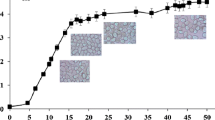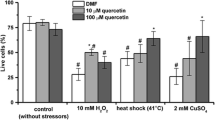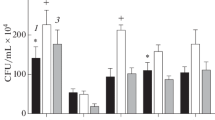Abstract
Antioxidant enzymes can modify cell response to nitrosative stress induced, for example, by nitric oxide or compounds decomposing with its formation. Therefore, we investigated the effects of S-nitrosoglutathione (GSNO) on cell survival, activity of antioxidant enzymes, and concentrations of reduced and oxidized glutathione in parental and isogenic strains defective in Cu,Zn- or Mn-superoxide dismutases (Cu,Zn-SOD and Mn-SOD, respectively), or in both of them. Stress was induced by incubation of the yeast with 1–20 mM GSNO. The strains used demonstrated different sensitivity to GSNO. A Cu,Zn-SOD-defective strain survived the stress better than the parental strain, while the double mutant was the most sensitive to GSNO. The ·NO-donor at low concentrations (1–5 mM) increased SOD activity, but its high concentrations (10 and 20 mM) decreased it. The activity of catalase in all strains was enhanced by GSNO. Inhibition of protein synthesis by cycloheximide did not prevent the activation of SOD, but it prevented the activation of catalase. These facts suggest that SOD was activated at a posttranslational level and catalase activity was enhanced via de novo synthesis. A GSNO-induced increase in oxidized glutathione level in the studied yeast strains might account for cell killing by GSNO due to the development of oxidative/nitrosative stress.
Similar content being viewed by others
Abbreviations
- GR:
-
glutathione reductase
- GSH:
-
reduced glutathione
- GSNO:
-
S-nitrosoglutathione
- GSSG:
-
oxidized glutathione
- ·NO:
-
nitric oxide
- RNS:
-
reactive nitrogen species
- SOD:
-
superoxide dismutase
References
Jakubowski, W., Bilinski, T., and Bartosz, G. (1999) Biochim. Biophys. Acta, 1472, 395–398.
Horan, S., Bourges, I., and Meunier, B. (2006) Yeast, 23, 519–535.
Sahoo, R., Dutta, T., Das, A., Ray, S. S., Sengupta, R., and Ghosh, S. (2006) Free Rad. Biol. Med., 40, 625–631.
Cassanova, N., O’Brien, K. M., Stahl, B. T., McClure, T., and Poyton, R. O. (2005) J. Biol. Chem., 280, 7645–7653.
Liu, L., Zeng, M., Hausladen, A., Heitman, J., and Stamler, J. S. (2000) Proc. Natl. Acad. Sci. USA, 97, 4672–4676.
Noble, D. R., Swift, H. R., and Williams, D. L. H. (1999) Chem. Commun., 2317–2318.
Liu, S. X., Xuan, B. O., Chen, Z., Varma, R. S., and Chiou, G. C. (1997) J. Ocul. Pharmacol. Ther., 13, 105–114.
Gralla, E. B., and Valentine, J. S. (1991) J. Bacteriol., 173, 5918–5920.
Lushchak, V., Semchyshyn, H., Lushchak, O., and Mandryk, S. (2005) Biochem. Biophys. Res. Commun., 338, 1739–1744.
Lushchak, V., Semchyshyn, H., Mandryk, S., and Lushchak, O. (2005) Arch. Biochem. Biophys., 441, 35–40.
Akerboom, T. P. M., and Sies, H. (1981) Meth. Enzymol., 77, 373–382.
Bradford, M. M. (1976) Anal. Biochem., 72, 289–292.
Klink, M., Swierzko, A., and Sulowska, Z. (2001) Apmis, 109, 493–499.
Gralla, E. B. (1997) in Oxidative Stress and the Molecular Biology of Antioxidant Defenses (Scandalios, J. G., ed.) Cold Spring Harbor Press, N. Y., pp. 495–525.
Bayliak, M. M., Semchyshyn, H. M., and Lushchak, V. I. (2006) Biochemistry (Moscow), 71, 1013–1020.
Alvarez, B., and Radi, R. (2003) Amino Acids, 25, 295–311.
Lushchak, O. V., and Lushchak, V. I. (2008) Redox Report, 13, 144–152.
Kim, Y.-M., Bergonia, H. A., Muller, C., Pitt, B. R., Watkins, W. D., and Lancaster, J. R. (1995) Adv. Pharmacol., 34, 277–291.
Wink, D. A., Hanbauer, I., Grisham, M. B., Laval, F., Nims, R. W., Laval, J., Cook, J., Pacelli, R., Liebmann, J., Krishna, M., Ford, R. C., and Mitchell, J. B. (1996) Curr. Top. Cell. Regul., 34, 159–187.
Halliwell, B., and Gutterige, J. M. C. (1989) Free Radicals in Biology and Medicine, Clarendon Press, Oxford.
Longo, V. D., Gralla, E. B., and Valentine, J. S. (1996) J. Biol. Chem., 271, 12275–12280.
Radi, R., Beckman, J. S., Bush, K. M., and Freeman, B. A. (1991) J. Biol. Chem., 266, 4244–4250.
Author information
Authors and Affiliations
Corresponding author
Additional information
Published in Russian in Biokhimiya, 2009, Vol. 74, No. 4, pp. 550–557.
Rights and permissions
About this article
Cite this article
Lushchak, O.V., Nykorak, N.Z., Ohdate, T. et al. Inactivation of genes encoding superoxide dismutase modifies yeast response to S-nitrosoglutathione-induced stress. Biochemistry Moscow 74, 445–451 (2009). https://doi.org/10.1134/S0006297909040130
Received:
Revised:
Published:
Issue Date:
DOI: https://doi.org/10.1134/S0006297909040130




